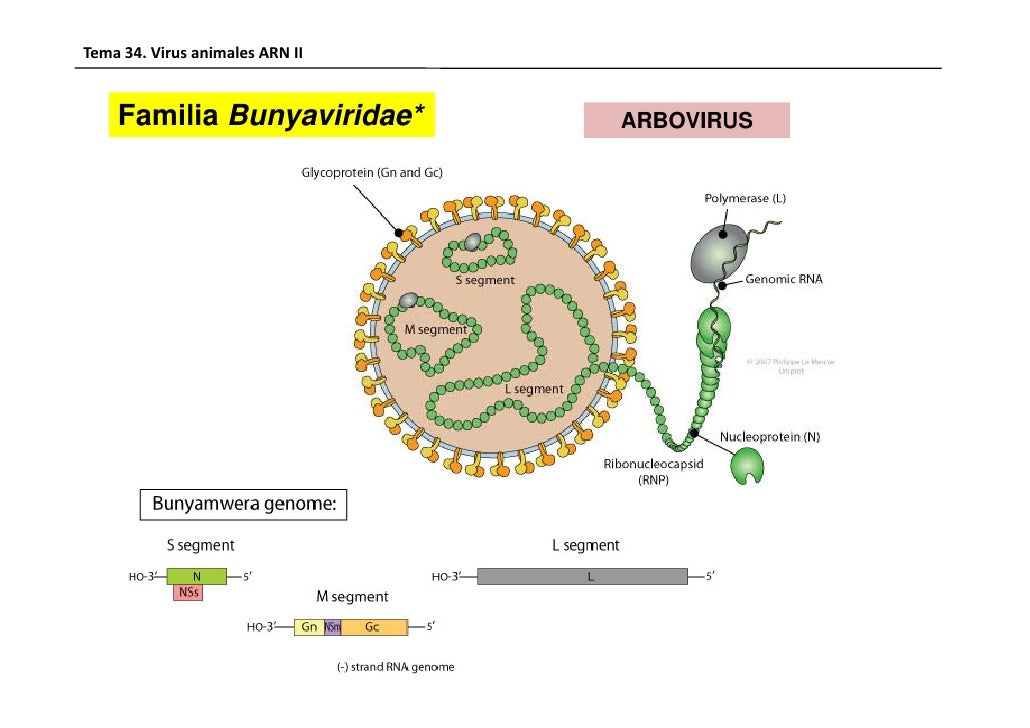Bunyaviridae
The Bunyaviridae family comprises enveloped viruses with a single-stranded, segmented RNA genome. The RNA segments are predominantly negative polarity, but also partly ambisense RNA.
The first representatives of the Bunyaviridae have been in the place Bunyamwera (Uganda ) isolated, from which the name of the family is derived.
Morphology
The virions of the Bunyaviridae have a round to irregular in shape and are sorted by genre 80-120 nm in size. In the two viral envelope glycoprotein 5-10 nm long spikes (viral proteins Gn and Gc) are incorporated. The capsid ( a Ribonukleokapsid ) is 2 to 2.5 nm thick and depending on the length of the RNA strand 200-3000 nm long and helical symmetry.
The viral genome consists of one molecule of three single-stranded RNAs with negative or mixed (ie ambisense, / -) polarity. They are used as L (large ), M (medium ) and S ( small) respectively. The ends of the individual RNA segments are complementary, so that they close to three non -covalently closed rings ( with ring-shaped capsids ). The sequence of these terminal RNA segments are highly conserved within a genus. The segmentation of the genome of a genetic reassortment ( reassortment ) is similar to the Orthomyxoviridae (e.g. influenza viruses) possible, which has already been shown for some species in vitro and in vivo.
Bunyaviruses all have four structural proteins: the two envelope proteins Gc and Gn (encoded in the M -segment), the nucleocapsid protein N ( in the S- segment), and a large RNA polymerase molecule L (on the L segment). A further 1-2 non-structural proteins ( NSm and NSs ) still little researched function depending on the genus coded M or S segment; the genus Hantavirus has no other non-structural protein.
Biological Properties
The bunyaviruses ( with the exception of the genus tospovirus ) can multiply alternatively in vertebrates and insects. During replication in vertebrate cells loosen the cell ( cytolytic ) while little or no cytopathological changes are observed in insect cells. The individual virus species are very closely matched to their vertebrate and insect host.
The different viral species are transmitted by mosquitoes, ticks, sandflies ( Phlebotomus genus ) and other insects as vectors. Is so far for hantaviruses not yet known, such a vector; with them an airborne transmission is described, and a non- cytopathogenic persistence in rodents as a host.
A special position is occupied by the genus tospovirus, because they only attack plants and thrips ( Thysanoptera ) are transmitted.
System
- Genus Orthobunyavirus 48 species, including:
- Bunyamwera virus
- Batai virus ( BATV ) - human flu-like symptoms and rashes
- Akabane virus - in ruminants and Cache Valley virus in sheep
- And another 3 provisional species
- Genus Hantavirus 22 species, including:
- Hantaanvirus - natural infections, especially in rodents, some of which also can cause hemorrhagic fever in humans
- Sin Nombre virus - natural infections, especially in rodents, one of which can also trigger some hemorrhagic fever in humans
- Genus Nairovirus 7 species, including:
- Crimean-Congo fever virus
- Nairobi sheep disease virus -
- Genus Phlebovirus 9 species, including:
- Rift Valley fever virus
- And an additional 16 provisional species
- Genus tospovirus ( plant viruses ) 8 species
- And another 6 provisional species
In addition to the unclassified species the family Bunyaviridae comprises seven groups of 19 virus species and a further 21 ungrouped species, which still has not been assigned genre.










